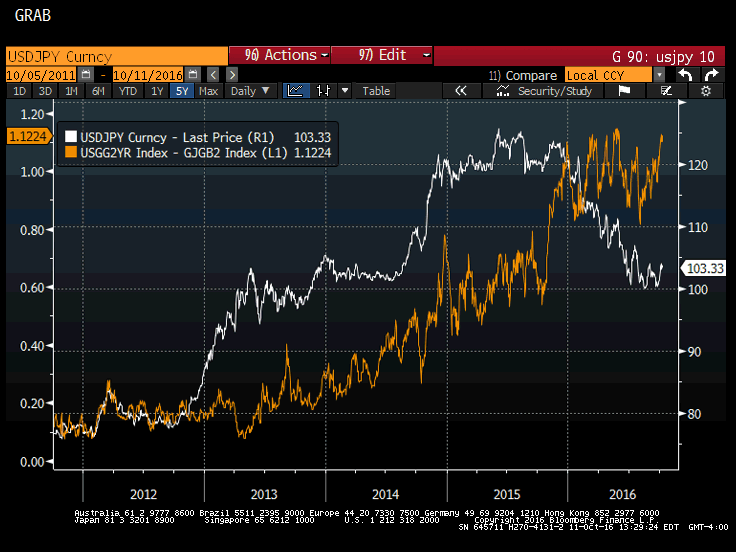It didn’t take long for sterling to make a run for its flash-crash low. The British pound traded heavily throughout the North American session and when stops were triggered at 1.22, it was a quick slide below 1.21. The flash-crash low is 1.1950 and while we can’t say whether this level will be reached in the near term, it certainly appears that GBP/USD will make a run for 1.2000. There will be many stops and option barriers sitting near that level, so the bounce off this rate should be even stronger than the 50-pip retrace we saw off 1.21 on Tuesday. Between rising U.S. yields, Brexit fears, a massive current account deficit and now dovish comments from Bank of England officials, sterling has had a very difficult time recovering from last week’s slide. Newly appointed BoE monetary policy committee member Saunders said the central bank has not run out of ammunition and indicated that he would not be surprised if the pound fell further. Kashyap added that a hard Brexit could see a lower currency. As these negative headlines flowed in, the “flash crash” became a lasting move in sterling.
Investors are dumping sterling left and right and that sell-at all-costs sentiment won’t change until BoE Governor Carney says he’s unhappy about the abruptness of the move or Prime Minister May suggests that Brexit terms could be negotiable. Either seems unlikely since a weak currency helps to achieve the central bank’s goals and cushions the economy against future contraction by boosting inflation, supporting trade and attracting tourism. But at some stage the move becomes excessive and policymakers may feel compelled to slow the currency’s slide. Given that GBP is deeply oversold, when a positive headline hits, the reversal will be quick and aggressive.
Broad-based dollar gains played a major role in sterling’s weakness Tuesday and while GBP/USD was the worst-performing major currency pair, NZD/USD, AUD/USD and EUR/USD also fell approximately 1% with EUR/USD and NZD/USD falling to 2-month lows. The dollar has been on a tear thanks in large part to the sharp rise in U.S. yields, which climbed to their highest level since June. The following chart shows a major disconnect between the move in U.S. rates (orange line) and USD/JPY (white line). Divergences like these don’t last for long and we firmly believe that USD/JPY will break above 104 and catch up with the move in rates. We have heard from a number of U.S. policymakers since Friday’s disappointing nonfarm payrolls report and they haven’t given up on their plan to raise rates. Even Chicago Fed President Evans -- one of the most dovish members of the FOMC -- said overnight that he would be open to a rate hike in December. The minutes from the September FOMC meeting will be released Wednesday and with 3 policymakers voting in favor of raising interest rates, we expect hawkish undertones that will keep investors convinced that rates will rise in December. Janet Yellen made it clear that the case for a rate hike has strengthened and that view should resonate in the Fed minutes. Fed Presidents Dudley and George are also scheduled to speak on Wednesday.
Despite stronger-than-expected investor confidence, the euro dropped to its weakest level versus the U.S. dollar in 2 months. Investors grew more confident about the current conditions in Germany’s economy and according to the ZEW survey, they are the most optimistic about the Eurozone’s outlook since June. Unfortunately that did not prevent the euro from falling below 1.1100 to 1.1050. Industrial production numbers are scheduled for release Wednesday and if German trade and ZEW surveys can’t lift the euro, we doubt that IP will. Instead, the single currency will take its cue from the market’s appetite for U.S. dollars.
With the Dow Jones Industrial Average falling more than 200 points intraday, it's no surprise that the Australian, New Zealand and Canadian dollars traded sharply lower as investors unwound carry trades. The New Zealand dollar was the worst performer courtesy of comments from RBNZ Assistant Governor McDermott, who sent the currency tumbling when he said inflation remains low and central-bank policy remains accommodative. Australia reported mixed data with home loans for the month of August dropping 3% compared to a forecast of 1.5%. NAB Business Conditions surprised to the upside with a reading of 8 vs. 7 the prior period. Canada also reported positive data with housing starts reaching 220.6k. After getting a boost on Monday from Putin’s agreement to work with OPEC on adjustments to supply, oil prices gave back some gains but stayed above $51 as investors wait for more clarity on the OPEC deal. OPEC’s secretary general Barkindo said Wednesday that although a production cut/freeze was in order, the conglomerate was not targeting a specific price target. IEA also warned that without a production cut, the market would be over supplied until mid 2017. There are no economic data reports scheduled for release from the commodity-producing countries Wednesday.

